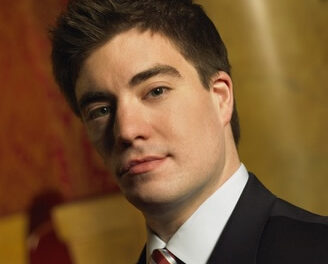 The North Carolina Symphony streamed a performance of works by Copland and Mozart on Saturday night. Directing the proceedings was guest conductor Andrew Grams, Music Director of the Elgin (IL) Symphony Orchestra.
The North Carolina Symphony streamed a performance of works by Copland and Mozart on Saturday night. Directing the proceedings was guest conductor Andrew Grams, Music Director of the Elgin (IL) Symphony Orchestra.
Aaron Copland (United States, 1900-90) wrote his famous Appalachian Spring on a 1942 commission from Elizabeth Sprague Coolidge (United States, 1854-1963). The work, on “an American theme,” was for choreographer/dancer Martha Graham (United States, 1894-1991).
Joseph Peters, Saturday evening’s host, is the associate principal oboe and English horn player for the North Carolina Symphony. In his introductory remarks, he credited Copland’s works as “largely responsible for defining the sound of American classical music. . . . Works of populism. Easy on the ears, easily understood on first listening.”
The 1970 Suite from Appalachian Spring was written for 13 players including flute, oboe bassoon, piano and strings. (On this occasion, the NCS had additional strings, for a total of 18 players.) The 25-minute composition is in eight sections.
The opening “Very slow intro, introduction to characters” brings Copland’s trademark slowly unfolding harmony to the fore. The sound was rich, with winds easily coming through the string haze.
The languid mood is broken by the “Elated and religious, fast” section that follows; the players jumped into this lively section. The “Moderate, duo for Bride and her Intended” featured fine playing from the winds, with the bassoon and clarinet in the spotlight. The tender conducting of Grams captured the mood perfectly.
“Quite fast; Revivalist and his flock” is a lark. Great fun, with great fiddling and perky motifs. One must point out the important role played by the piano, which provides a percussive timbre vital to the score. “Faster . . solo dance of the bride” continues the good spirit. “Very slow (as at first)” provides fine contrast.
“Calm and flowing” includes the famous Shaker melody “Simple Gifts.” The set of variations on the tune are probably some of Copland’s finest writing. The “Moderate” final movement provides a gentle coda, a wonderful ending to a fine performance.
Throughout, the musicians played with great intonation and tight ensemble, and Grams flexible conducting sparked both excitement and gentle encouragement.
Wolfgang Amadeus Mozart (Austria, 1756-91) wrote his Symphony No. 33 in B-flat, K.319, in 1779, in Salzburg. It is a relatively modest affair, written for two oboes, two bassoons, two horns and strings. Its overall joyous mood belies the discontentment Mozart felt by not finding a better position than court organist/concertmaster in his hometown. The symphony was originally written in three movements, but the composer added a fourth movement Minuet and Trio later in Vienna to accommodate the taste of the audiences there.
The opening dance-like movement is perky, cheerful, and elegant. Grams’ animated conducting never got in the way. The slower second movement is warm and gentle, with the violins taking the lead throughout. All is elegance and clarity. The movement also contains some nice writing for the winds, giving them time in the spotlight.
The Minuet is a bit more agitated than a gentle dance. Although the program notes state the Minuet is in a “dark mood” in contrast to the rest of the symphony, I don’t find it so. Operatic arias influence the lively finale. This is a fun, scurrying movement, with hints that mischievous tricks are afoot.
It was a delight to experience the great acoustics of the hall in this live performance. Although intonation was not always perfect, the NCS played with sensitivity and energy, a winning combination.
The concert concluded with a short discussion with principal oboist Melanie Wilsden. Host Peters asked her what it was like to play with a live orchestra. “Oh, my goodness!” Playing the Mozart was “so upbeat and positive…, I couldn’t stop smiling inside when I was playing it.” I’m sure the entire audience shared her upbeat sentiments.











